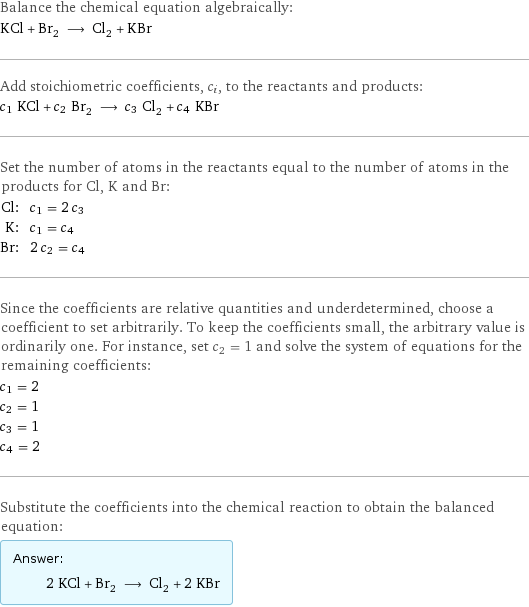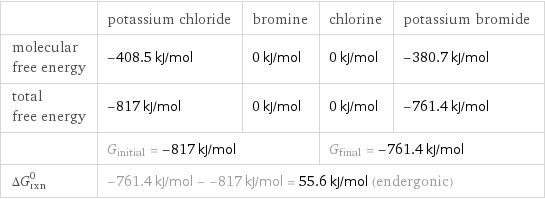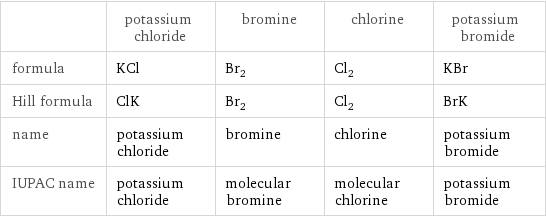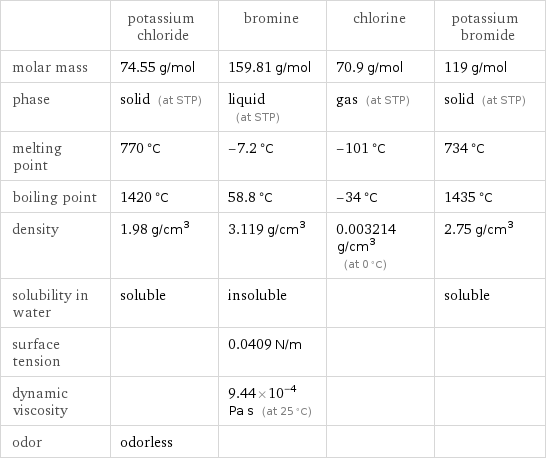Input interpretation

KCl potassium chloride + Br_2 bromine ⟶ Cl_2 chlorine + KBr potassium bromide
Balanced equation

Balance the chemical equation algebraically: KCl + Br_2 ⟶ Cl_2 + KBr Add stoichiometric coefficients, c_i, to the reactants and products: c_1 KCl + c_2 Br_2 ⟶ c_3 Cl_2 + c_4 KBr Set the number of atoms in the reactants equal to the number of atoms in the products for Cl, K and Br: Cl: | c_1 = 2 c_3 K: | c_1 = c_4 Br: | 2 c_2 = c_4 Since the coefficients are relative quantities and underdetermined, choose a coefficient to set arbitrarily. To keep the coefficients small, the arbitrary value is ordinarily one. For instance, set c_2 = 1 and solve the system of equations for the remaining coefficients: c_1 = 2 c_2 = 1 c_3 = 1 c_4 = 2 Substitute the coefficients into the chemical reaction to obtain the balanced equation: Answer: | | 2 KCl + Br_2 ⟶ Cl_2 + 2 KBr
Structures

+ ⟶ +
Names

potassium chloride + bromine ⟶ chlorine + potassium bromide
Reaction thermodynamics
Enthalpy

| potassium chloride | bromine | chlorine | potassium bromide molecular enthalpy | -436.5 kJ/mol | 0 kJ/mol | 0 kJ/mol | -393.8 kJ/mol total enthalpy | -873 kJ/mol | 0 kJ/mol | 0 kJ/mol | -787.6 kJ/mol | H_initial = -873 kJ/mol | | H_final = -787.6 kJ/mol | ΔH_rxn^0 | -787.6 kJ/mol - -873 kJ/mol = 85.4 kJ/mol (endothermic) | | |
Gibbs free energy

| potassium chloride | bromine | chlorine | potassium bromide molecular free energy | -408.5 kJ/mol | 0 kJ/mol | 0 kJ/mol | -380.7 kJ/mol total free energy | -817 kJ/mol | 0 kJ/mol | 0 kJ/mol | -761.4 kJ/mol | G_initial = -817 kJ/mol | | G_final = -761.4 kJ/mol | ΔG_rxn^0 | -761.4 kJ/mol - -817 kJ/mol = 55.6 kJ/mol (endergonic) | | |
Equilibrium constant
![Construct the equilibrium constant, K, expression for: KCl + Br_2 ⟶ Cl_2 + KBr Plan: • Balance the chemical equation. • Determine the stoichiometric numbers. • Assemble the activity expression for each chemical species. • Use the activity expressions to build the equilibrium constant expression. Write the balanced chemical equation: 2 KCl + Br_2 ⟶ Cl_2 + 2 KBr Assign stoichiometric numbers, ν_i, using the stoichiometric coefficients, c_i, from the balanced chemical equation in the following manner: ν_i = -c_i for reactants and ν_i = c_i for products: chemical species | c_i | ν_i KCl | 2 | -2 Br_2 | 1 | -1 Cl_2 | 1 | 1 KBr | 2 | 2 Assemble the activity expressions accounting for the state of matter and ν_i: chemical species | c_i | ν_i | activity expression KCl | 2 | -2 | ([KCl])^(-2) Br_2 | 1 | -1 | ([Br2])^(-1) Cl_2 | 1 | 1 | [Cl2] KBr | 2 | 2 | ([KBr])^2 The equilibrium constant symbol in the concentration basis is: K_c Mulitply the activity expressions to arrive at the K_c expression: Answer: | | K_c = ([KCl])^(-2) ([Br2])^(-1) [Cl2] ([KBr])^2 = ([Cl2] ([KBr])^2)/(([KCl])^2 [Br2])](../image_source/c9c754b47e91e1deb01981d84dffa6f7.png)
Construct the equilibrium constant, K, expression for: KCl + Br_2 ⟶ Cl_2 + KBr Plan: • Balance the chemical equation. • Determine the stoichiometric numbers. • Assemble the activity expression for each chemical species. • Use the activity expressions to build the equilibrium constant expression. Write the balanced chemical equation: 2 KCl + Br_2 ⟶ Cl_2 + 2 KBr Assign stoichiometric numbers, ν_i, using the stoichiometric coefficients, c_i, from the balanced chemical equation in the following manner: ν_i = -c_i for reactants and ν_i = c_i for products: chemical species | c_i | ν_i KCl | 2 | -2 Br_2 | 1 | -1 Cl_2 | 1 | 1 KBr | 2 | 2 Assemble the activity expressions accounting for the state of matter and ν_i: chemical species | c_i | ν_i | activity expression KCl | 2 | -2 | ([KCl])^(-2) Br_2 | 1 | -1 | ([Br2])^(-1) Cl_2 | 1 | 1 | [Cl2] KBr | 2 | 2 | ([KBr])^2 The equilibrium constant symbol in the concentration basis is: K_c Mulitply the activity expressions to arrive at the K_c expression: Answer: | | K_c = ([KCl])^(-2) ([Br2])^(-1) [Cl2] ([KBr])^2 = ([Cl2] ([KBr])^2)/(([KCl])^2 [Br2])
Rate of reaction
![Construct the rate of reaction expression for: KCl + Br_2 ⟶ Cl_2 + KBr Plan: • Balance the chemical equation. • Determine the stoichiometric numbers. • Assemble the rate term for each chemical species. • Write the rate of reaction expression. Write the balanced chemical equation: 2 KCl + Br_2 ⟶ Cl_2 + 2 KBr Assign stoichiometric numbers, ν_i, using the stoichiometric coefficients, c_i, from the balanced chemical equation in the following manner: ν_i = -c_i for reactants and ν_i = c_i for products: chemical species | c_i | ν_i KCl | 2 | -2 Br_2 | 1 | -1 Cl_2 | 1 | 1 KBr | 2 | 2 The rate term for each chemical species, B_i, is 1/ν_i(Δ[B_i])/(Δt) where [B_i] is the amount concentration and t is time: chemical species | c_i | ν_i | rate term KCl | 2 | -2 | -1/2 (Δ[KCl])/(Δt) Br_2 | 1 | -1 | -(Δ[Br2])/(Δt) Cl_2 | 1 | 1 | (Δ[Cl2])/(Δt) KBr | 2 | 2 | 1/2 (Δ[KBr])/(Δt) (for infinitesimal rate of change, replace Δ with d) Set the rate terms equal to each other to arrive at the rate expression: Answer: | | rate = -1/2 (Δ[KCl])/(Δt) = -(Δ[Br2])/(Δt) = (Δ[Cl2])/(Δt) = 1/2 (Δ[KBr])/(Δt) (assuming constant volume and no accumulation of intermediates or side products)](../image_source/d77163d171f9533d7f345c00b25ad613.png)
Construct the rate of reaction expression for: KCl + Br_2 ⟶ Cl_2 + KBr Plan: • Balance the chemical equation. • Determine the stoichiometric numbers. • Assemble the rate term for each chemical species. • Write the rate of reaction expression. Write the balanced chemical equation: 2 KCl + Br_2 ⟶ Cl_2 + 2 KBr Assign stoichiometric numbers, ν_i, using the stoichiometric coefficients, c_i, from the balanced chemical equation in the following manner: ν_i = -c_i for reactants and ν_i = c_i for products: chemical species | c_i | ν_i KCl | 2 | -2 Br_2 | 1 | -1 Cl_2 | 1 | 1 KBr | 2 | 2 The rate term for each chemical species, B_i, is 1/ν_i(Δ[B_i])/(Δt) where [B_i] is the amount concentration and t is time: chemical species | c_i | ν_i | rate term KCl | 2 | -2 | -1/2 (Δ[KCl])/(Δt) Br_2 | 1 | -1 | -(Δ[Br2])/(Δt) Cl_2 | 1 | 1 | (Δ[Cl2])/(Δt) KBr | 2 | 2 | 1/2 (Δ[KBr])/(Δt) (for infinitesimal rate of change, replace Δ with d) Set the rate terms equal to each other to arrive at the rate expression: Answer: | | rate = -1/2 (Δ[KCl])/(Δt) = -(Δ[Br2])/(Δt) = (Δ[Cl2])/(Δt) = 1/2 (Δ[KBr])/(Δt) (assuming constant volume and no accumulation of intermediates or side products)
Chemical names and formulas

| potassium chloride | bromine | chlorine | potassium bromide formula | KCl | Br_2 | Cl_2 | KBr Hill formula | ClK | Br_2 | Cl_2 | BrK name | potassium chloride | bromine | chlorine | potassium bromide IUPAC name | potassium chloride | molecular bromine | molecular chlorine | potassium bromide
Substance properties

| potassium chloride | bromine | chlorine | potassium bromide molar mass | 74.55 g/mol | 159.81 g/mol | 70.9 g/mol | 119 g/mol phase | solid (at STP) | liquid (at STP) | gas (at STP) | solid (at STP) melting point | 770 °C | -7.2 °C | -101 °C | 734 °C boiling point | 1420 °C | 58.8 °C | -34 °C | 1435 °C density | 1.98 g/cm^3 | 3.119 g/cm^3 | 0.003214 g/cm^3 (at 0 °C) | 2.75 g/cm^3 solubility in water | soluble | insoluble | | soluble surface tension | | 0.0409 N/m | | dynamic viscosity | | 9.44×10^-4 Pa s (at 25 °C) | | odor | odorless | | |
Units
